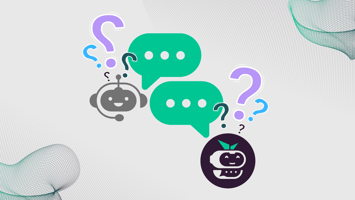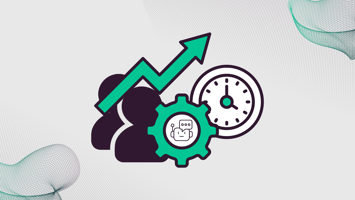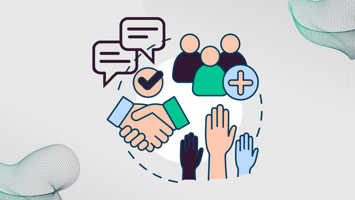In the ever-evolving landscape of digital interactions, chatbots have emerged as essential tools for organizations across various industries seeking to streamline user interactions and optimize operational efficiency.
One prominent type of chatbot that has taken center stage is the customer service chatbot, which uses AI, machine learning, and natural language understanding (NLU) to answer customer questions and automate routine tasks.
However, this type of bot is not to be confused with generative chatbots built on AI language models, which can understand and generate human-like text across a broad range of topics.
So, if your organization is considering implementing a chatbot—which is right for you?
In this blog post, we'll explore the four considerations for selecting the AI chatbot uniquely positioned for your organization's success.
1. Define the Purpose of Your Chatbot
Do you want your chatbot to assist your customer service team address incoming user inquiries? Or are you looking for a chatbot to act as a built-in member of your customer engagement team? Or, you're hoping for a chatbot solution that does both (and more). Defining your bot's primary purpose and objective is of the utmost importance to selecting a tool that drives success for your organization.
A customer service chatbot's primary goal is to support the customer service team by handling tickets and resolving queries efficiently. It is primarily task-oriented, designed to promptly address specific customer inquiries and issues.
Conversely, a generative chatbot tailored to a specific organization, like Betty Bot, emphasizes engaging users and creating personalized interactions. Its primary purpose is enhancing user experience, fostering brand loyalty, and building emotional connections with members.
2. Consider Required Functionalities for Your Chatbot
Not all chatbots are created alike—look at how different experiences have been using Microsoft's Bing AI chatbot, for example. For this reason, your organization should carefully consider what functionalities are required of your chatbot and which are not.
Below are the six most critical chatbot functionalities we recommend exploring.
- Model architecture, including NLP (natural language processing) and NLU. How advanced are the AI technologies the bot is built on, and what are its parameters?
-
- Customer service chatbots are typically built on specific task-oriented architectures tailored to handle predefined service tasks, such as answering FAQs, processing transactions, and resolving customer issues.
- Generative chatbots utilize deep neural networks, enabling them to understand and generate responses across a broad range of topics.
- Versatility. How broad of a skillset do you want your bot to have? What types of tasks should it be able to complete?
- Customer service bots excel in handling specific tasks within a confined domain.
- At the same time, generative chatbots can engage in various conversational engagements, such as answering questions, providing explanations, creative writing, and more.
- Content analysis and training protocols. How rigorous is the testing period? What are the content and data parameters a chatbot can be trained on? Strenuous testing and feedback sessions guarantee your chatbot's responses meet your organization's expectations.
- Typically, customer service chatbots are trained on organization information. such as FAQs or knowledge base articles to help answer and resolve customers' questions.
- Generative chatbots designed for specific industries, such as Betty Bot for member-based organizations, can be trained on an organization’s entire treasure trove of internal and external content, including case studies, whitepapers, product descriptions, event calendars, blog posts, and more.
- Response customization and personalization. How tailored do you want your chatbot's responses to be?
- Customer service bots may need additional context from a user to connect their inquiry with previous interactions.
- Generative chatbots retain context during conversations, enabling organizations to keep a running conversation log with each user or member, further personalizing each response.
- Integrations. Ensure the chatbot you're considering can integrate and talk to your current systems, such as your CRM, customer support software, website, and mobile apps.
- Learning and continuous improvements. Your chatbot should evolve with your users, not become stale after a few weeks or months of use. Be sure to ask providers whether their chatbots have advanced NLP capabilities, allowing them to improve responses over time, and how often a chatbot is trained on new content and updated datasets.
3. Determine User Engagement Needs
It should come as no surprise that user and member engagement are highly correlated with overall profitability and success.
According to Gartner, effective customer engagement can increase member loyalty and trust, boosts member experience, and improve sales funnel velocity, among other things.
If your chatbot's goal is to enhance your members' overall experience, you should determine what level of engagement the bot can deliver.
Efficiency and accuracy are typically the most prioritized features for standard customer service chatbots—not user engagement. Instead, emphasis is placed on delivering accurate information swiftly and resolving issues effectively.
Generative chatbots, on the other hand, are all about engaging users in meaningful conversations. They can hold dynamic discussions, ask follow-up questions to understand user needs better and create a human-like conversational experience to keep members captivated.
While an AI customer service chatbot can streamline ticket handling and assist the support team in providing quick solutions, a generative chatbot goes beyond mere problem-solving. It elevates the customer journey by delivering personalized, engaging interactions that forge stronger emotional connections between members and the organization.
4. Consider Limitations
While AI-enabled chatbots offer numerous benefits, organizations should consider several limitations and challenges before implementing them.
When using a customer service chatbot, organizations' most significant limitations are a limited understanding of complex queries and handling complex scenarios. AI customer service bots typically fall back to predefined responses when faced with an inquiry they cannot understand or respond to accurately.
Conversely, generative chatbots rely heavily on the quality and relevance of the data used for training. Therefore, one of the most severe limitations of this chatbot type is inaccurate responses due to inadequate or biased data. You'll want to work with your chatbot provider to ensure the content you're using for training is clean, organized, and relevant.
Test Drive a Generative Chatbot Now
To sum up, there are significant distinctions between strictly customer service chatbots and generative chatbots, and these differences should not be disregarded.
We recommend testing both chatbots for yourself as if you were a member of your organization to determine which would provide the most value to your team and constituents.
You can test a generative chatbot designed exclusively for associations by clicking the button below.
.png?width=173&height=70&name=Betty_RGB%201%20(1).png)



